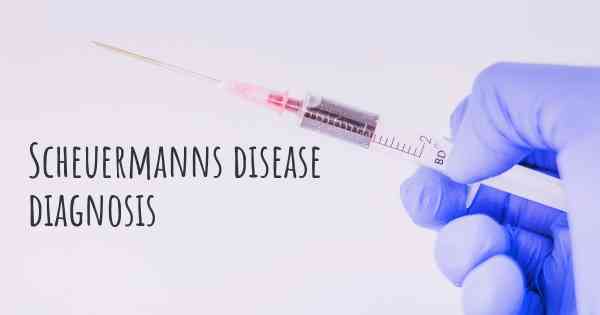How is Scheuermanns disease diagnosed?
See how Scheuermanns disease is diagnosed. Which specialists are essential to meet, what tests are needed and other useful information for the diagnosis of Scheuermanns disease

Diagnosing Scheuermann's Disease
Scheuermann's disease, also known as Scheuermann's kyphosis, is a condition that affects the spine, particularly during adolescence. It is characterized by abnormal growth of the vertebrae, leading to an increased curvature of the upper back or thoracic spine. Diagnosing Scheuermann's disease typically involves a combination of medical history evaluation, physical examination, and diagnostic imaging.
Medical History Evaluation
The first step in diagnosing Scheuermann's disease is a thorough medical history evaluation. The healthcare provider will ask questions about the patient's symptoms, such as back pain, stiffness, or changes in posture. They will also inquire about any family history of spinal conditions or other relevant medical conditions. This information helps in understanding the patient's overall health and identifying potential risk factors for Scheuermann's disease.
Physical Examination
During the physical examination, the healthcare provider will assess the patient's posture, spinal alignment, and range of motion. They may ask the patient to perform certain movements or exercises to evaluate their flexibility and identify any abnormalities. The provider will also palpate the spine to check for tenderness, muscle tightness, or any noticeable deformities. This examination helps in identifying potential signs of Scheuermann's disease and ruling out other possible causes of back pain or spinal abnormalities.
Diagnostic Imaging
Diagnostic imaging plays a crucial role in confirming the diagnosis of Scheuermann's disease. The most commonly used imaging techniques include X-rays and magnetic resonance imaging (MRI).
X-rays
X-rays provide detailed images of the bones and can reveal the characteristic changes associated with Scheuermann's disease. The healthcare provider will typically request standing X-rays of the spine, including both lateral (side) and anterior-posterior (front and back) views. These X-rays help in assessing the degree of spinal curvature, the shape of the vertebrae, and the presence of any wedging or irregularities. The provider may also measure the angle of kyphosis, which is the degree of forward curvature in the upper back.
Magnetic Resonance Imaging (MRI)
In some cases, an MRI may be recommended to obtain more detailed information about the spinal structures, such as the intervertebral discs, spinal cord, and surrounding soft tissues. MRI can help identify any additional abnormalities or complications that may be present, such as herniated discs or spinal cord compression. This imaging technique is particularly useful when there are neurological symptoms or concerns.
Differential Diagnosis
It is important to differentiate Scheuermann's disease from other conditions that may cause similar symptoms or spinal abnormalities. Some of the conditions that may be considered in the differential diagnosis include postural kyphosis, congenital kyphosis, spinal infections, and spinal tumors. The medical history, physical examination findings, and imaging results help in ruling out these alternative diagnoses and confirming Scheuermann's disease.
Consultation with a Specialist
If Scheuermann's disease is suspected or diagnosed, the healthcare provider may refer the patient to a specialist, such as an orthopedic surgeon or a spine specialist. These specialists have expertise in managing spinal conditions and can provide further evaluation, treatment recommendations, and long-term management plans.
It is important to note that this answer is for informational purposes only and should not be considered a substitute for professional medical advice. A healthcare provider should always be consulted for an accurate diagnosis and appropriate treatment options.
MRI
CAT scan
Visual inspection for most people
Posted Feb 28, 2017 by Mikeloveskorn 1720
This follows with an x-ray.
Posted Nov 8, 2017 by Gaia Jasmine 2800








